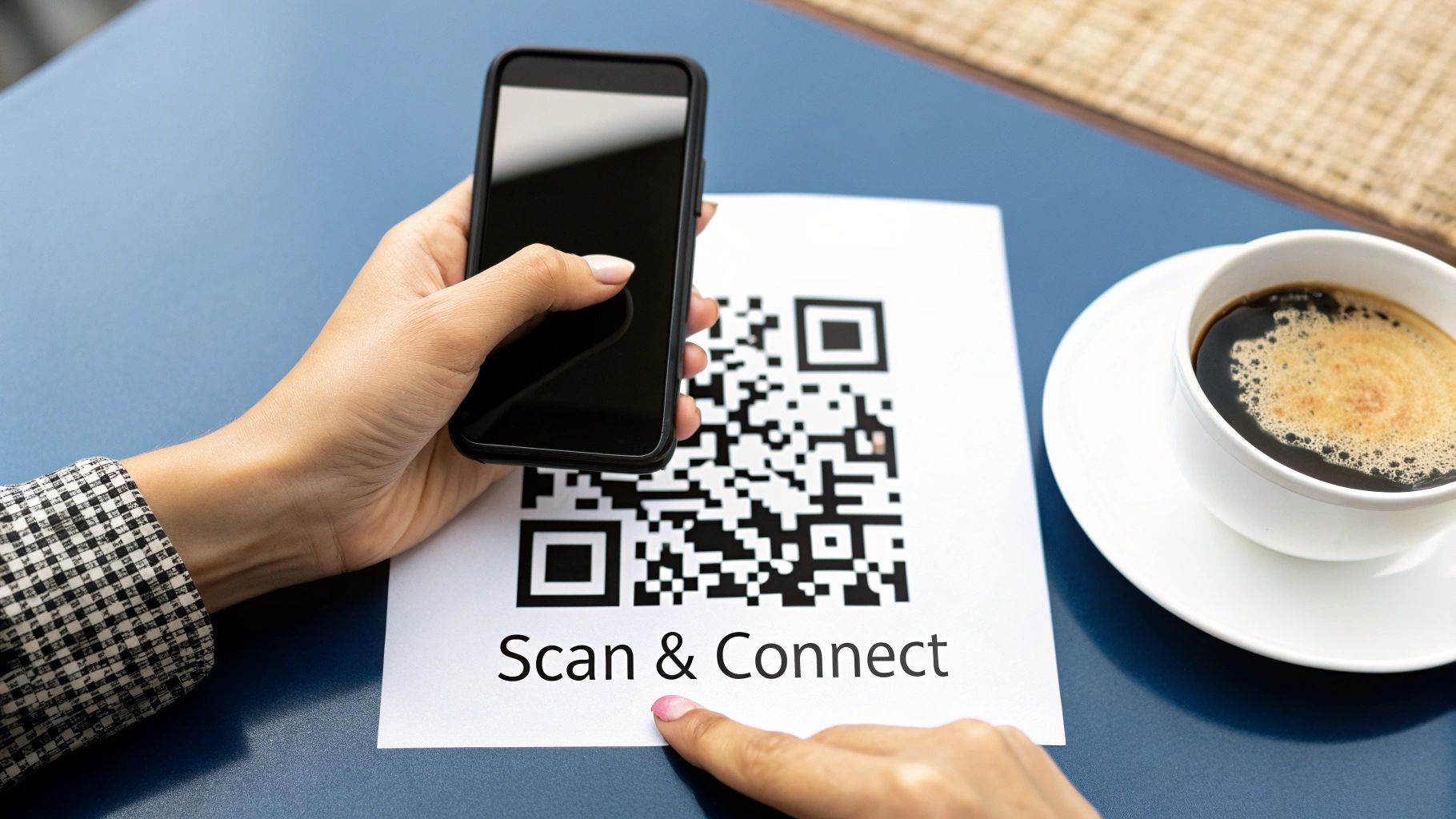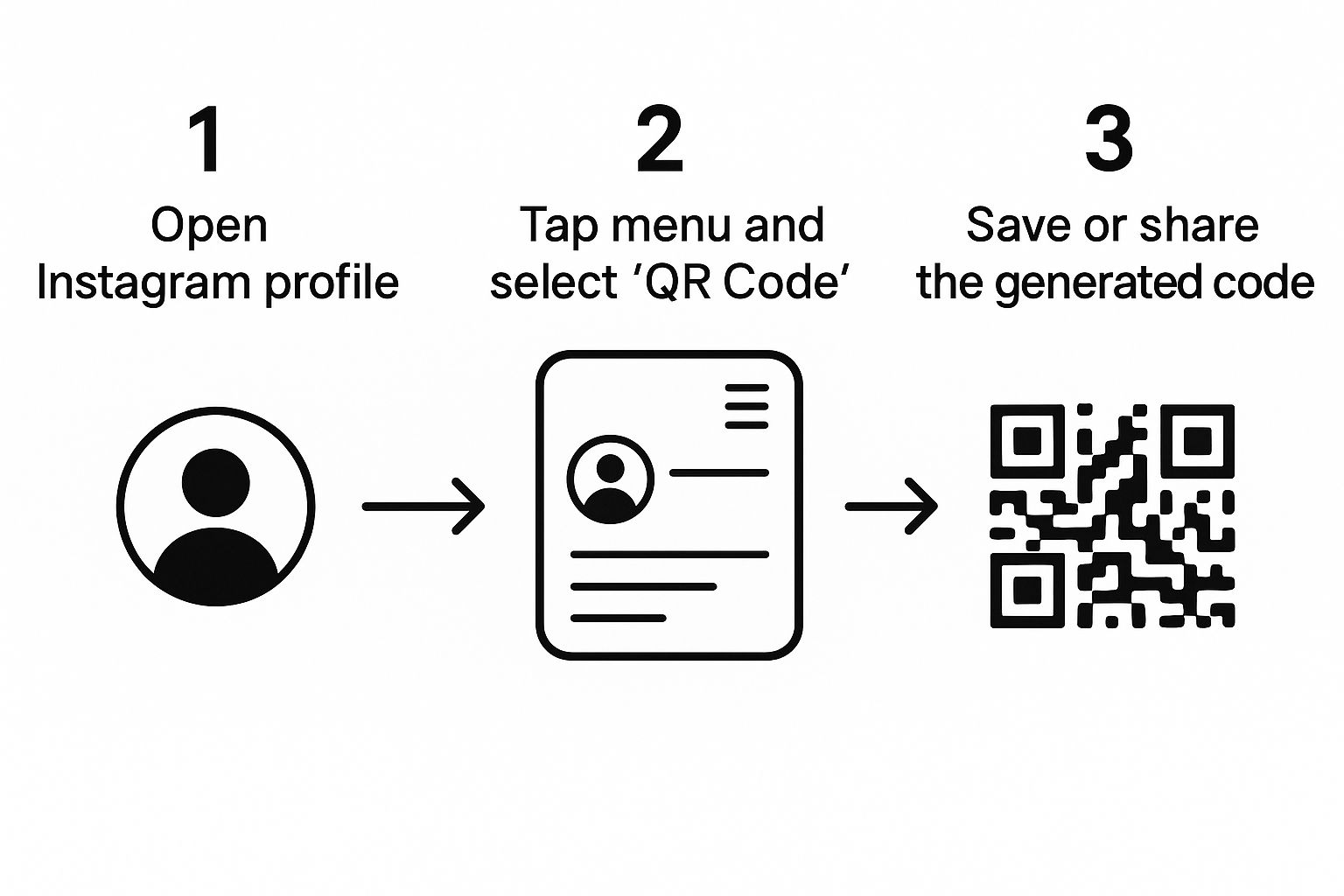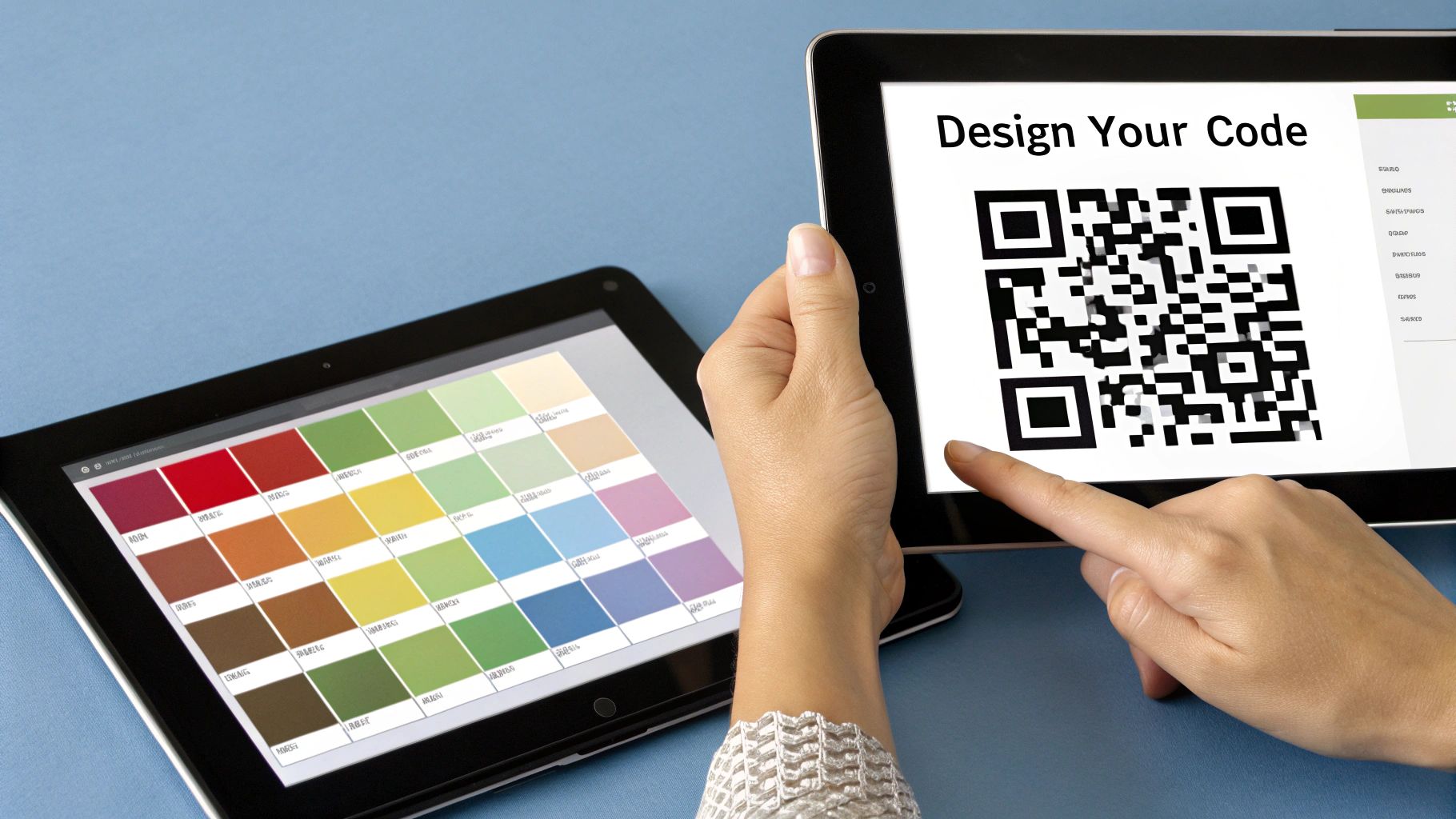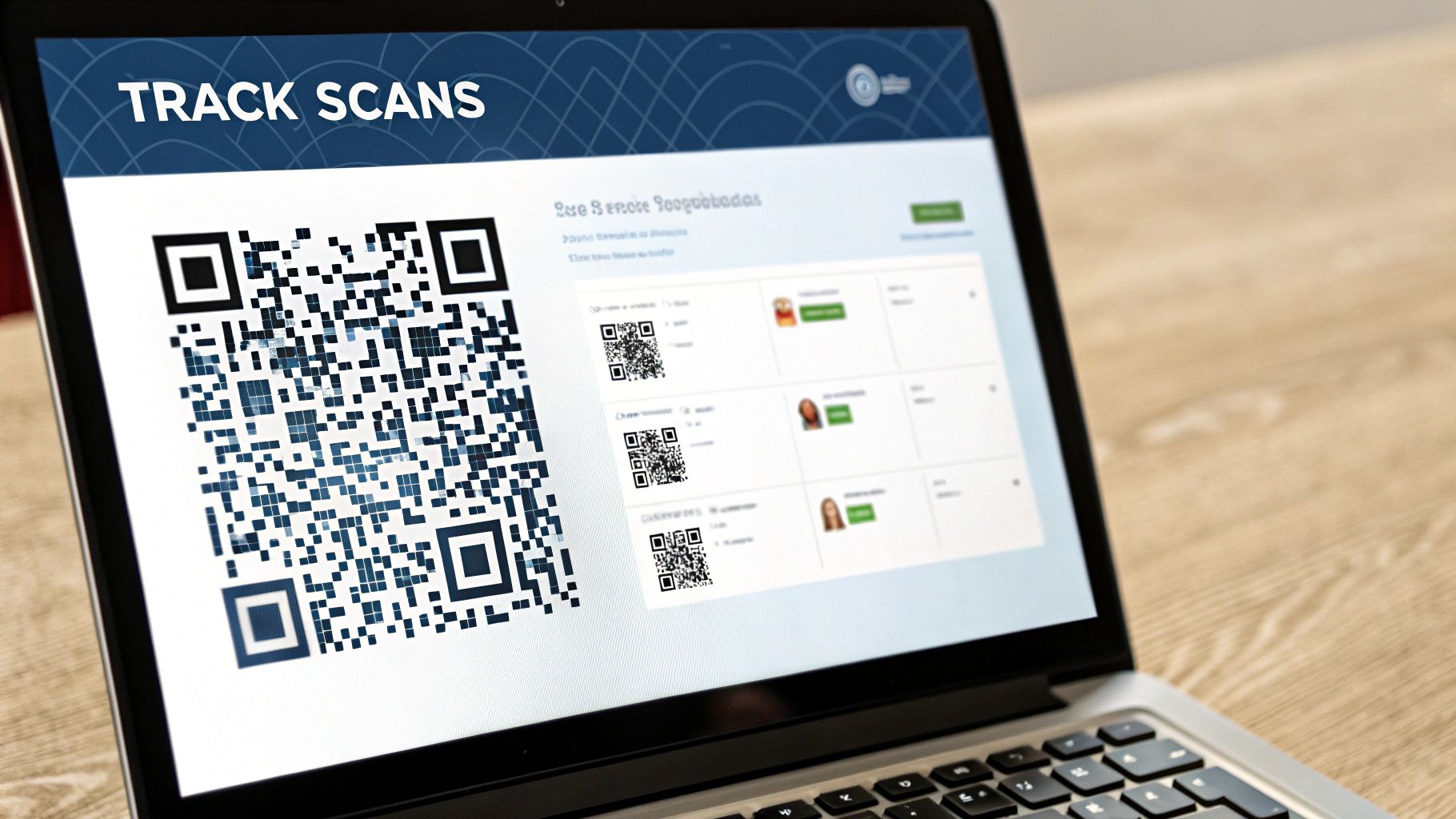QR Codes on Instagram How to Boost Engagement
July 2, 2025
Using QR codes on Instagram is a fantastic way to connect your physical marketing with your digital presence. It's about more than just a link; it's about giving customers a dead-simple path to find your profile, see your content, and follow you with a quick scan.
Why QR Codes Are a Game-Changer for Instagram

Think of QR codes as direct portals to your Instagram. They completely remove the friction of someone having to open the app and manually search for your username - a small step, but a real barrier.
With a QR code, they can instantly connect with your brand, whether they're standing in your store, unboxing a product, or sitting at a table in your café. This immediate connection turns passive observers into active followers.
Bridging Your Physical and Digital Worlds
The real magic happens when you use QR codes to link your offline efforts directly to specific, valuable content on Instagram.
Let me give you a few real-world examples I've seen work wonders:
- In a retail store: A QR code on a product tag could link straight to an Instagram Reel showing that exact item being used.
- At a restaurant: A code on the corner of the menu might encourage diners to follow your profile for a chance to win a weekly giveaway.
- On an event banner: A big, bold QR code could send attendees to a post with an exclusive discount just for them.
In every case, the QR code doesn't just point to your profile page; it delivers something targeted and useful right when it matters most.
And this isn't just a gimmick. The data shows QR codes are now a part of everyday consumer behavior. A detailed 2025 report found that by 2025, 59% of consumers are expected to scan QR codes daily. Even better, QR-initiated campaigns on platforms like Instagram can hit an average click-through rate of 37%—beating many other digital channels.
The key takeaway is simple: QR codes turn any physical touchpoint into an interactive marketing opportunity, driving measurable engagement directly to your Instagram account.
This strategy helps you build a more engaged and loyal community. By making it effortless for people to find and follow you, you're actively growing your audience with every single scan.
To help you brainstorm, I've put together a table with some common ways businesses are using Instagram QR codes and what they hope to achieve.
Instagram QR Code Use Cases and Impact
| Use Case | Where to Place the QR Code | Primary Goal |
|---|---|---|
| Profile Growth | Business cards, store windows, event flyers | Increase follower count |
| Product Showcase | Product packaging, in-store displays, print ads | Drive traffic to specific product posts or Reels |
| Contests & Giveaways | Restaurant menus, table tents, event banners | Boost engagement and brand interaction |
| Exclusive Content | Receipts, "thank you" cards, shipping inserts | Reward customers and build loyalty |
| User-Generated Content | On packaging or in-store signage | Encourage customers to tag you in their posts |
| Event Promotion | Posters, tickets, presentation slides | Share event-specific info or a special offer |
Thinking through these scenarios can help you pinpoint the best way to get started. Pick one goal, place your QR code strategically, and watch the scans roll in.
How to Create Your First Instagram QR Code
Creating a QR code that links to your Instagram is a fantastic way to connect your real-world marketing efforts with your online presence. You can whip one up in just a few minutes, whether you're using Instagram's own built-in tool or a more advanced generator like RecodeQR for extra features.
The quickest method is right inside the Instagram app, which is perfect for sharing your profile link on the fly. This infographic breaks down just how simple it is.

As you can see, it only takes a few taps to find and share your personal Instagram QR code. This makes it incredibly handy for in-person networking or quick shares.
Generating Your First Code
First things first, you need to decide what you want people to do when they scan your code. Are you trying to boost your follower count? In that case, linking to your main profile is the way to go.
Or maybe you're running a specific campaign, like a product launch or a giveaway. For that, you’ll want to send people directly to a specific post, Reel, or Story Highlight. This is where QR codes get really powerful.
Once you know your destination, the rest is easy:
- Grab your Instagram URL. Go to your profile or the specific post you want to use and copy its full URL.
- Choose a QR code generator. In a tool like RecodeQR, you'll want to select the standard "URL" or "Website" option. It's the most common and versatile type.
- Paste your link and generate. Just paste the Instagram link into the field and click to create your code. You’ll instantly get a standard black-and-white QR code, ready to download and use.
The real magic of a QR code for Instagram is getting specific. Instead of just dumping people on your profile page, you can guide them to the exact content that matters in that moment. That's how you boost engagement.
This simple process is part of a much bigger trend. Around the world, about 8 QR codes are generated every single minute, largely because they work so well with social media. This is fueling a projected 47% year-over-year growth in QR code creation, proving they’re becoming a must-have for modern marketing.
Putting Your Code into Action
Let's say you run a local bakery and you're launching a new seasonal doughnut. You could create a QR code that links directly to the Instagram post showing it off.

The screenshot above shows an example of a brand's feed where a single, eye-catching post would be perfect for a targeted QR code. By sending customers straight to that content, you create a smooth journey from seeing a flyer in your shop to drooling over the post online.
You can learn more about crafting the perfect QR code for Instagram in our detailed guide.
Designing a QR Code That Reflects Your Brand

Sure, a generic black-and-white QR code gets the job done. But let's be honest, it’s a massive missed branding opportunity. Think of it like a business card with just a name and number - it's functional, but totally forgettable.
A custom-designed QR code, on the other hand, acts as a visual handshake. It builds trust and brand recognition before anyone even points their camera at it.
When someone sees a code that uses your brand colors and logo, it just feels more intentional and secure. This is a small but powerful detail for encouraging scans, since a plain code can feel anonymous or even a little sketchy. Using a tool like RecodeQR lets you go way beyond the default, turning a simple utility into a real marketing asset.
Infusing Your Brand’s Visual Identity
Your brand has its own unique vibe, and your QR code should absolutely reflect it. This isn't just about making things look pretty; it's about creating a smooth, cohesive experience that connects your physical marketing materials directly to your Instagram profile.
The goal? Make your QR code instantly recognizable as yours.
Here are the key things you can tweak:
- Brand Colors: Ditch the standard black and white. Use your primary or secondary brand colors for the code's pattern and background. It's the quickest way to create a visual link to your brand.
- Embedded Logo: Placing your company logo - or even just the Instagram icon - in the center of the QR code gives people immediate context. It answers the question, "Where is this taking me?"
- Pattern and Shape: You can even change the shape of the little data blocks and corner markers. Swapping the default squares for circles or other custom shapes adds a subtle but unique flair.
With just a few simple changes, you transform a boring, functional tool into an engaging piece of marketing that actually grabs attention and gets more scans.
Critical Design Principles for Scannability
While getting creative is great, never forget the code's number one job: it has to be scannable. A beautiful QR code that doesn't work is completely useless. It's all about finding that sweet spot between eye-catching design and technical reliability.
The most important rule is high contrast. A light-colored pattern on a light background (or dark on dark) will almost certainly fail to scan. Always pair a dark foreground color with a light background to ensure smartphone cameras can easily read the code.
You also want to avoid visual clutter. Adding a logo is a fantastic touch, but make sure it doesn't cover up too much of the code's data area, especially those critical corner squares. QR codes have built-in error correction that allows for some customization, but pushing it too far can make the code unreadable.
If you want to dive deeper into this, our guide on QR code branding has more advanced tips and best practices. And my final piece of advice: always, always test your final design with multiple phones before you print anything.
Alright, you've created a beautiful, branded QR code. That's a great start. But a QR code sitting on your computer is useless. Its real power comes from putting it where people will actually see it and, more importantly, scan it.
The goal is to make scanning feel like a natural, almost instinctive next step for anyone interacting with your brand. Think of your QR code as the bridge connecting your physical world - your products, your store, your events - to your digital home on Instagram.
This isn't about just slapping a code anywhere and hoping for the best. Context is everything. The right placement, combined with a compelling reason to scan, is what separates a code that gets ignored from one that drives real follower growth.
Strategic Offline Placements
Your physical touchpoints are prime real estate for your Instagram QR code. These are golden opportunities to catch the attention of customers who are already right there, physically engaging with your business.
Here are a few high-impact offline locations I’ve seen work wonders:
- Product Packaging: This is a huge one. Someone has already bought your product, which makes them the perfect candidate to become a follower. Add a QR code with a call-to-action like, "Scan to see how to style this!" that links directly to an Instagram Reel or a "how-to" post.
- In-Store Displays: Place QR codes near new arrivals or featured products. A simple sign that says, "Scan to join our VIP list for early access" can drive follows and make customers feel special.
- Restaurant Menus & Table Tents: Diners almost always have a little downtime while waiting for their food. A code on the menu with "Follow us for weekly specials!" is a brilliant way to convert a one-time customer into a long-term follower who keeps coming back.
- Business Cards and Flyers: Don't just list your Instagram handle and hope they type it in later. A scannable code makes it effortless for new connections to find you. Make it inviting with simple text like, "Scan to connect with us on Instagram."
This approach isn't just a niche trick anymore; it's becoming mainstream. Recent industry analysis shows that 46% of U.S. marketers are actively using QR codes in their campaigns. It's an especially powerful tactic for bridging offline and online marketing, a technique used by 37% of marketers to boost engagement. Industries like retail and food service have seen massive lifts, with usage jumping by 40% and 21% respectively.
Smart Digital Placements
Don't box your thinking into just physical items. Your digital assets offer some of the best opportunities to cross-promote your Instagram profile and funnel followers from your other channels.
A well-placed QR code turns every marketing asset - whether printed or digital - into a direct on-ramp to your Instagram community. It's about being present wherever your audience already is.
You can strategically sprinkle your QR code across various digital spaces to steer traffic directly to your Instagram account.
Effective Digital Locations:
| Digital Asset | Placement Idea & Call-to-Action |
|---|---|
| Email Signatures | Add a small QR code under your name with simple text like, "Follow my journey on Instagram." |
| Other Social Profiles | Use the QR code as a banner image on platforms like LinkedIn or X with text overlaid: "Scan for behind-the-scenes content on IG!" |
| Presentation Slides | End your webinar or presentation with a final slide featuring a large QR code. Say something like, "Scan this to continue the conversation on Instagram." |
| Website 'About' Page | Pop the code in when you introduce your team or brand story. A simple "Scan to see our team in action!" can add a personal touch. |
Tracking Performance to Optimize Your Campaigns

Getting your branded QR code out there is a great start. But the real magic happens when you understand who is scanning it, where they are, and when. This is how you move from just using QR codes to using them strategically.
This kind of analysis is only possible with dynamic QR codes. Unlike their static cousins, which are fixed forever, dynamic codes send users through a special trackable link first. It’s this detour that allows a platform like RecodeQR to capture anonymous data with every scan, turning your marketing materials into a measurable campaign.
Without that data, you’re basically flying blind.
Unlocking Key Metrics in Your Dashboard
Once your dynamic QR code is live, your RecodeQR dashboard becomes your mission control. It's way more than a simple scan counter; it’s a direct window into your audience's behavior.
Here are the key metrics you'll want to keep an eye on:
- Total Scans: The big-picture number showing overall engagement. How popular is this code?
- Unique Scans: This shows you how many different people have scanned your code. It's the best measure of your campaign's true reach.
- Scan Location: See the city and country where scans are happening. This is perfect for confirming if your local print campaign is actually hitting the right geographic area.
- Time of Day: Find out the peak hours and days people are scanning. You can use this to time your Instagram posts for maximum impact.
- Device Type: Is your audience mostly on iOS or Android? This can be surprisingly useful for future app-based marketing or technical decisions.
By analyzing this data, you're no longer guessing. You can confidently answer questions like, "Which of our marketing materials is actually working?" and "When is our audience most likely to engage with us?"
This is the kind of analytical power that maximizes your return on investment. If you want to dive deeper into the basics, our guide on creating a trackable QR code is a great place to start.
Turning Data into Actionable Strategy
Raw numbers are interesting, but insights that drive growth are what really matter. Let's walk through a real-world scenario to see how this plays out.
Imagine a retail shop puts a custom QR code on two different physical items: a poster inside their flagship store and a printed flyer distributed around the neighborhood. Both codes lead straight to the brand's Instagram profile.
After two weeks, they log into their RecodeQR analytics and see this:
- In-Store Poster: 250 total scans
- Printed Flyer: 45 total scans
The results are crystal clear. The in-store poster is crushing the flyer by more than 5 to 1. Armed with this concrete data, the brand can now make a smart, informed decision. They can pull the plug on the flyers and reallocate that budget toward more in-store displays, maybe even testing new poster designs or placements to see if they can beat their own record.
This is how tracking transforms a simple QR code from a neat gimmick into a powerful optimization tool for your entire Instagram strategy.
Of course. Here's the rewritten section, designed to match the expert, human-written style of the provided examples.
Answering Your Instagram QR Code Questions
Once you start using QR codes in your Instagram marketing, a few questions always come up. I get asked these all the time, so let's clear up some of the common points of confusion so you can use them with confidence.
Can I Link a QR Code to an Instagram Story?
This is probably the most frequent question I hear. While you can't link directly to a single Story that vanishes in 24 hours, there's a fantastic workaround: link to a Story Highlight.
Think about it. You could create a "New Arrivals" or "Q&A" Highlight that lives permanently on your profile. Then, you can put a QR code on your product packaging or at an event with a call-to-action like, "Scan to see our latest drops!" This sends people to curated content that feels fresh without the 24-hour expiry date.
You can also link directly to your Reels tab by just copying that URL from your desktop browser. It’s a perfect way to show off your entire video portfolio with a single scan.
What's the Big Deal with Dynamic QR Codes?
Another thing that often trips people up is the difference between static and dynamic QR codes. What exactly is a dynamic QR code, and why is it so important for a platform like Instagram?
A static QR code is simple: your Instagram URL is permanently baked into it. If you want to change that link - say, from your main profile to a new contest post - you have to create and print a whole new code. That's fine for a link that never changes, but it's incredibly limiting for active marketing.
A dynamic QR code, which you can create with a tool like RecodeQR, is much smarter. It uses a short redirect URL instead. This is a complete game-changer for a couple of reasons:
- You can edit the destination URL anytime. Just launched a new product? No problem. Just log into your dashboard and update the link to point to the new Instagram post. You don't have to reprint a single flyer.
- You get access to critical analytics. Dynamic codes track every scan, giving you real data on where, when, and on what device your code was scanned.
The ability to change the destination link on the fly and track performance is what makes dynamic QR codes an essential tool for serious marketers. It turns a simple link into a flexible, data-rich campaign asset.
How to Avoid Common QR Code Mistakes
Finally, let's talk about the pitfalls. I've seen too many well-intentioned QR code campaigns fall flat because of simple, avoidable mistakes. Knowing what they are ahead of time can make all the difference.
The single biggest mistake is a lack of clear instruction. Just slapping a QR code on a flyer with no context is a surefire way to have it ignored. You have to give people a compelling reason to pull out their phone. A call-to-action (CTA) is non-negotiable. "Scan to follow us" is okay, but "Scan for 15% off your next order" is infinitely better.
Other frequent slip-ups include:
- Printing the code too small. Test it yourself! A code on a tiny business card needs to be a different size than one on a huge trade show poster.
- Using a generic, unbranded design. A custom code that includes your logo not only looks more professional, but it also builds trust with your audience.
- Forgetting to test the code before printing. This one seems obvious, but it happens. Always scan your final design from a few different phones and at various distances to make sure it works perfectly.
Ready to create flexible, trackable QR codes on Instagram that you can update anytime? Get started with RecodeQR and see how easy it is to connect your physical marketing to your digital world. Explore our features and begin your free trial.
Ready to create your QR code?
RecodeQR is the easiest way to create QR codes you can track and edit anytime.
Free 3-day trial. No credit card required.